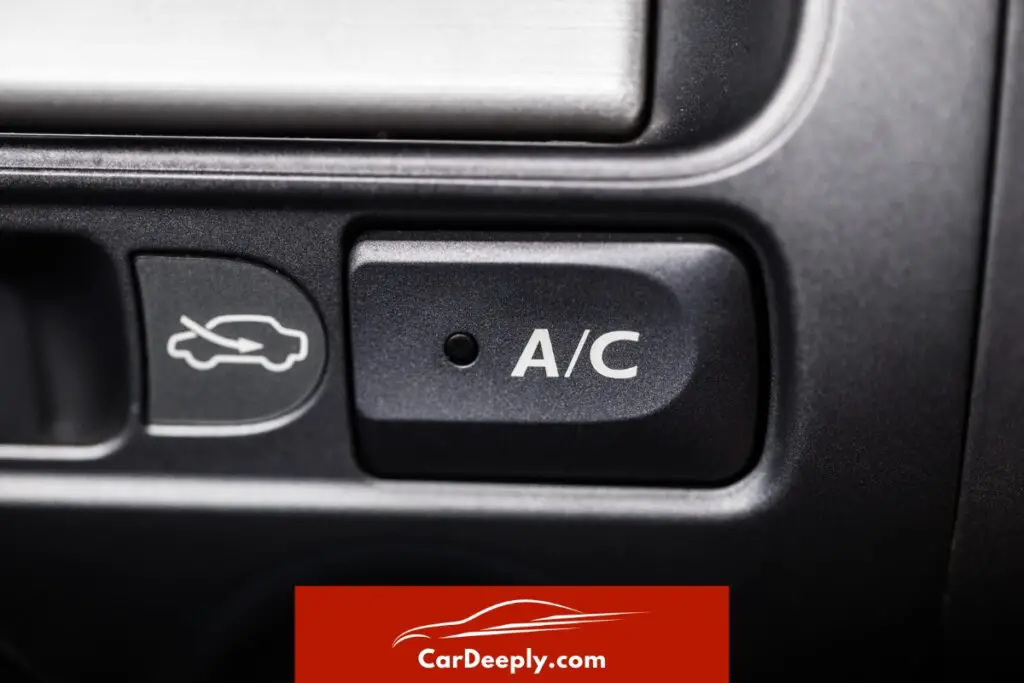Hot days can be unbearable without a functioning AC system in your RAV4.
However, AC leaks can put a damper on your driving experience and result in costly repairs.
This article explores how to prevent AC leaks and the cost of fixing them in a RAV4.
Advertising links are marked with *. We receive a small commission on sales, nothing changes for you.
Early Symptoms Of A Leaked Air Conditioner In RAV4

How can you tell if your RAV4’s air conditioner leaks? There are some early symptoms that you can look out for, such as:
- Your car AC is blowing warm or hot air instead of cold air.
- Your AC system makes strange noises, such as hissing, bubbling, or clicking.
- Your AC system emits a bad smell, such as a musty or rotten odor.
- Your AC system leaves water stains or puddles inside or underneath your vehicle.
- Your AC system is causing your engine to overheat or run poorly.
If you notice any of these symptoms, you should check your AC system for leaks immediately.
How And Why RAV4’s Air Conditioner Leaks
What causes your RAV4’s air conditioner to leak? There are several possible reasons, such as:
- Wear And Tear: Your AC system is exposed to friction, vibration, corrosion, heat, and moisture which can weaken components and create openings for refrigerant or coolant to escape. Hoses, seals, gaskets, and valves are most prone to wear and tear.
- Damage: External factors such as road debris, rocks, animals, or accidents can damage AC components, causing them to break or leak. The condenser, radiator, compressor, and evaporator are most susceptible to damage.
- Clogging: Dirt, dust, bugs, leaves, or other particles can accumulate on the AC system’s surface or in its gaps, causing blockages that lead to pressure buildup or ice formation. The air filter, grille, intake manifold, and thermal expansion valve will most likely get clogged.
How To Fix My Toyota RAV4 Air Conditioner Leak: Step-By-Step
Now that you know the causes and symptoms of a RAV4 AC leak, let’s see how to fix it.
Before we begin, you should make sure you have the following tools in hand, you’ll need them:
- A multimeter.
- A vacuum gauge.
- A voltmeter.
- A jumper wire.
- An infrared thermometer.
- A soap solution.
- A wire or compressed air.
- A manifold gauge set.
- A vacuum pump.
- Refrigerant and oil (according to the manufacturer’s specifications).
- Protective gloves and goggles.
Once you get all these tools, you can follow these eight steps to restore your AC system and enjoy a cool ride.
Step 1: Inspect the AC System for Leaks
To begin with, inspect the AC system for leaks.
Look for any signs of leaks or damage on the AC components, such as the drain pipe, drain hose, refrigerant lines, coolant reservoir, condenser, radiator, and evaporator.
You can try a soap solution test to confirm any leaks.
Step 2: Check the AC Flow Sensor and Vacuum Hose
Next, verify the AC flow sensor and vacuum hose. These parts help regulate the flow of refrigerant through the system.
You can use a multimeter to test the resistance of the sensor and a vacuum gauge to test the pressure of the hose.
If they are faulty, you need to replace them.
Step 3: Inspect the AC Condenser and Compressor
After that, examine the AC condenser and compressor. These parts cool and compress the refrigerant. You can look for any damage, leaks, or faults on them. If they are not working properly, you must also replace them.
You can also test the pressure switch with a voltmeter. It controls the compressor based on the refrigerant pressure. A bad switch can affect your AC performance.
While at it, you should also try bypassing the clutch with a jumper wire. It connects or disconnects the compressor from the engine. A faulty clutch can prevent your AC from working.
Step 4: Check the Thermal Expansion Valve
Then, check the thermal expansion valve. This part regulates the flow of refrigerant into the evaporator.
You can use an infrared thermometer to measure the temperature difference between the inlet and outlet of the valve.
If it is damaged or clogged, then you’ll need to replace it – it’s not repairable.
Step 5: Look for Crimps or Damage in the AC Hoses
Following that, look for crimps or damage in the AC hoses. These parts connect the different components of the AC system. You can use a visual inspection or a soap solution test to locate any leaks in them.
If they are damaged, you need to replace them.
Step 6: Check the AC Drain Location
Subsequently, check the AC drain location. This is where the water that condenses on the evaporator drains out of your vehicle.
If the AC drain is blocked, clogged or disconnected, you need to clear it with a wire or compressed air, or replace it if it is damaged.
Step 7: Recharge the AC System
Now recharge the AC system. You need to use a manifold gauge set and a vacuum pump to refill the system with refrigerant and oil.
You need to follow the manufacturer’s instructions for this process.
Step 8: Test the AC System
Lastly, test the AC system. You need to use a thermometer and a pressure gauge to check if your AC is blowing cold air inside your vehicle.
You need to make sure that everything is functioning as it should.
How Much Does It Cost To Fix AC Leak In RAV4?
The cost of fixing an AC leak in your RAV4 depends on the severity of the leak and parts needing replacement. Minor repairs can cost around $200 to $400, while major repairs can cost over $1000.
Preventing Future AC Leaks In Your RAV4
To avoid costly repairs down the line, preventing AC leaks in your RAV4 should be a top priority. Here are some tips to help you keep your AC system in top shape:
- Regular maintenance and inspections can detect potential issues before they turn into major problems.
- Keep your RAV4’s AC system clean and free of debris, which can cause blockages and put additional strain on the system.
- If you live in an area with harsh weather conditions, storing your RAV4 in a garage or covered area is recommended to protect it from external damage.
- Avoid overusing your RAV4’s AC system, as this can cause wear and tear on the components.
- Use high-quality refrigerant and have it changed on schedule to ensure proper function and avoid leaks.
- If you notice any issues with your RAV4’s AC system, such as strange noises or weak airflow, have it inspected by a certified mechanic as soon as possible to prevent further damage.
FAQs
Should you drive your RAV4 with an air conditioning leak?
No, it’s not recommended. Driving with an AC leak can cause further damage to the AC system and potentially harm other parts of the car.
How often should you service Toyota RAV4’s air conditioner?
Toyota recommends servicing the air conditioner every two years, though this can vary depending on factors such as climate and frequency of use. Check your owner’s manual or consult a qualified mechanic for specific recommendations.
Will a Toyota RAV4 air conditioner leak cause damage to other parts of the car?
Yes, it can. The refrigerant used in the AC system is harmful to the environment and can damage components like the compressor, condenser, and evaporator.
Final Thoughts
Your RAV4’s AC system is one of the best, providing comfort during long drives.
You can save yourself from the frustration and expense of fixing it in the heat by taking extra steps to keep your car’s AC in working condition before summer hits.
The extra effort will be worth it when you stay cool and relaxed on the road during the hottest days of summer.

Sebastian loves convertibles and drove a BMW 335i for a long time (325 hp is just a dream). Today, with two children, he is more concerned with SUVs and family-friendly vehicles. In addition to an Audi A4 Avant, he also drives a Cupra Formentor VZ – even as a family man, you can’t do without speed. Get to know Sebastian better and visit the About Us page.
Advertising links are marked with *. We receive a small commission on sales, nothing changes for you.

